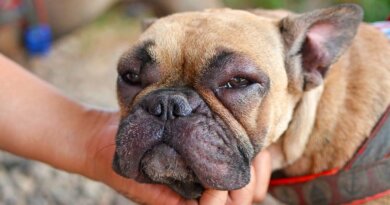Best Dog Food for Skin Allergies – Dogster
Disclaimer: If you purchase items through links on our site we may earn a commission.
Figuring out why your dog is so itchy and what to do about it can be complicated and frustrating.
Food allergies — and therefore, dog skin allergies — in dogs are becoming more common. The most frequently reported foods that cause allergic symptoms in dogs are beef, chicken, lamb, wheat, soy, walnuts and corn. However, dogs can be allergic to any foods containing small amounts of protein including fruits, vegetables and grains. Most food allergies can be successfully managed with a change in diet. Changing the meat source of your dog’s food, introducing a novel meat or feeding a hydrolyzed protein diet can help alleviate your pup’s symptoms.
How do I know if my dog is allergic to his food?
Food allergies and sensitivities can have many symptoms but often manifest as itchy skin. Environmental allergens can cause these same skin symptoms. Dogs with food allergies commonly have environmental allergies as well. Without treatment, these symptoms can become more severe over time.
Food allergy symptoms include:
- Repeated ear infections
- Rash around mouth and anus
- Anal gland infections and leakage
- Repeated skin infections (hot spots)
- Itchy skin
- Licking/chewing paws and legs
- Diarrhea
- Vomiting
- Reflux
What’s causing my dog’s food allergies?
The exact cause of food allergies and sensitivities is poorly understood. However, it is believed that genetics and the integrity of the intestines may play a role in the development of food allergies in dogs. Rotational diets have been thought to decrease the likelihood of developing food allergies. The rationale is that by rotating proteins daily, weekly, monthly or even seasonally, the body may not have time to become intolerant of any one protein. This theory has not been proven with any scientific evidence.
If I treat my dog’s food allergies, will it treat the skin allergies, too?
The best treatment for dogs with food allergies is to identify the offending foods and remove them from the diet. A small number of dogs will be able to resume eating those allergenic foods after several months of elimination. Dogs who are allergic to just one meat source may find immediate success in a diet change. However, dogs with several food allergies may require a more advanced diet strategy to diagnose and successfully treat their symptoms.
Work with your veterinarian to ensure that your dog’s skin allergy symptoms are not caused by other factors such as parasites, environmental allergies, stress or other diseases. Adding a veterinary dermatologist to your veterinary team can expand your pet’s treatment options. You can find a dermatologist near you.

Managing food allergies in dogs through diet
The following are several diet strategies that may be successful in treating dogs with food allergies:
New meat source diet
If you suspect your dog has a food allergy, the easiest change to make is switching the protein source in your dog’s diet. For example, if you are feeding a chicken-based diet, switch to a beef- or fish-based diet. Read the ingredient label carefully to ensure that there is only one protein source. For example, many pet food companies will add chicken to formulas that are advertised as having primarily fish in the recipe. Once you decide on a new protein source, check the ingredients in treats and supplements to ensure that your pup only gets one source of meat protein.
Limited ingredient diet
This diet limits the total number of ingredients, typically to one source of protein and one source of carbohydrate; for example, lamb and rice. These diets are commercially available over the counter or by prescription from a veterinarian. The advantage of prescription limited ingredient diets is that the manufacturing lines are more controlled, helping to prevent cross contamination from other formulas, which is important for extremely sensitive dogs. These diets can also be prepared at home as long as they are balanced. There are tools out there to help. For example, Balanceit.com is a website that helps pet owners design and balance a limited ingredient diet.
Novel Protein Diet
A novel protein is defined as a protein that your dog has never eaten before. This may decrease the likelihood that your dog will have a reaction. However, some foods are cross reactive. For example, a dog that is allergic to beef may also be allergic to lamb, even if he has never eaten lamb. Proteins that are often novel to dogs include duck, alligator, venison and kangaroo. These diets may also double as limited ingredient diets, as many of them are designed with itchy, allergic dogs in mind.
Hydrolyzed Protein Diet
These diets are regularly prescribed by veterinarians to diagnose and treat food allergies. To understand how these diets work, you need to understand the structure of a protein. Think of a protein like a strand of pearls. Each pearl is an amino acid. The longer the strand of pearls, the more likely the body is to consider it an allergen. Hydrolyzed diets are made up of proteins that are cut up into smaller strands of pearls. This makes each protein less likely to be allergenic. Soy, chicken and fish are commonly used to make these diets. Even though soy and chicken are common allergens, they become less allergenic when hydrolyzed into smaller proteins. Only feed this diet with hydrolyzed treats — adding other non-hydrolyzed treats could cause allergic symptoms in your dog. There are several different formulations and prescription brands of hydrolyzed diets. If your dog does not like the flavor or has symptoms while eating one, try another brand or formulation. Find examples of hydrolyzed diets here.
Amino Acid Based Diet
An amino acid based diet is like a hydrolyzed diet, but is further broken down into individual amino acids. This is like taking the strand of pearls and cutting it into individual pearls. This nearly eliminates the chances of your dog being allergic to this diet. This type of diet is only manufactured by one brand of prescription dog food. Like the hydrolyzed diet, this diet should be fed alone and without other treats and food. If this diet is effective in controlling your dog’s symptoms, it should be continued for at least 14 weeks. At that time, you can begin adding one single ingredient per week to the amino acid based diet. When adding foods back to your dog’s diet, start with foods that have less reaction potential, such as fruits and vegetables. This method will help you determine which foods cause your dog symptoms. It is safe for your dog to continue to eat the amino acid based diet for life. You can also switch to a home cooked diet or a commercial diet containing foods you have already tried that don’t cause symptoms. Amino acid based diets are less palatable compared to other diets. If your dog refuses to eat this diet, try switching to a hydrolyzed diet, which tends to be more palatable. Amino-acid based diets tend to be prescription only. An example is Royal Canin’s Ultamino dog food.
Finding the right diet to help treat your dog’s food allergies can be a process. Each time you switch your dog’s diet, take time to add in the new diet while slowly phasing out the old. Transition time should take four to seven days. You may need to try a few different diets before you find one that is effective. These diets may take four to six weeks to bring relief. Avoid treats and supplements that are not on the diet plan. No matter what type of diet strategy you are using, never stop giving your dog his prescription medications. Patience is critical! It may take up to six months to find a diet that not only works for your dog’s allergies, but is also an enjoyable flavor and consistency.




